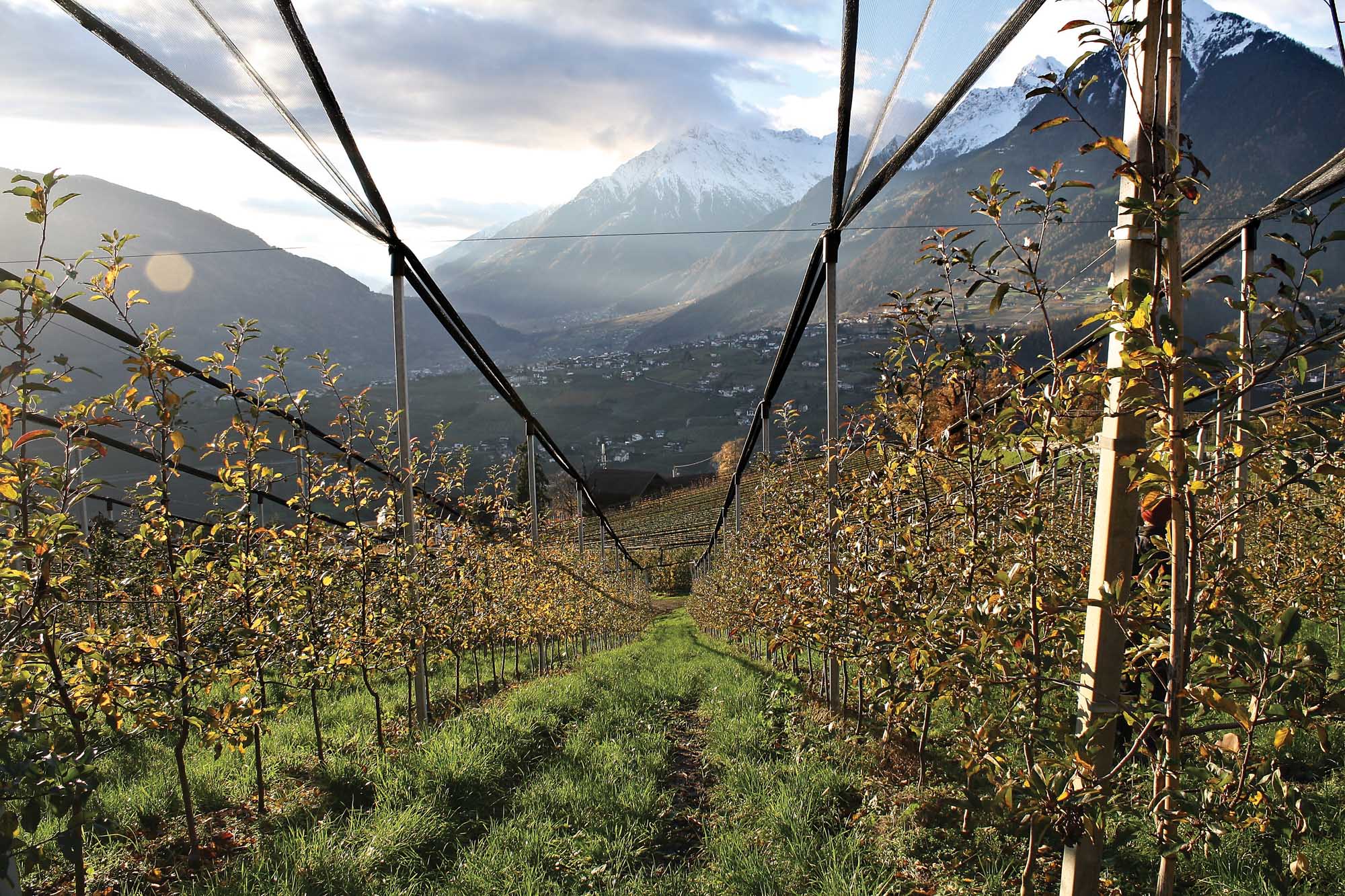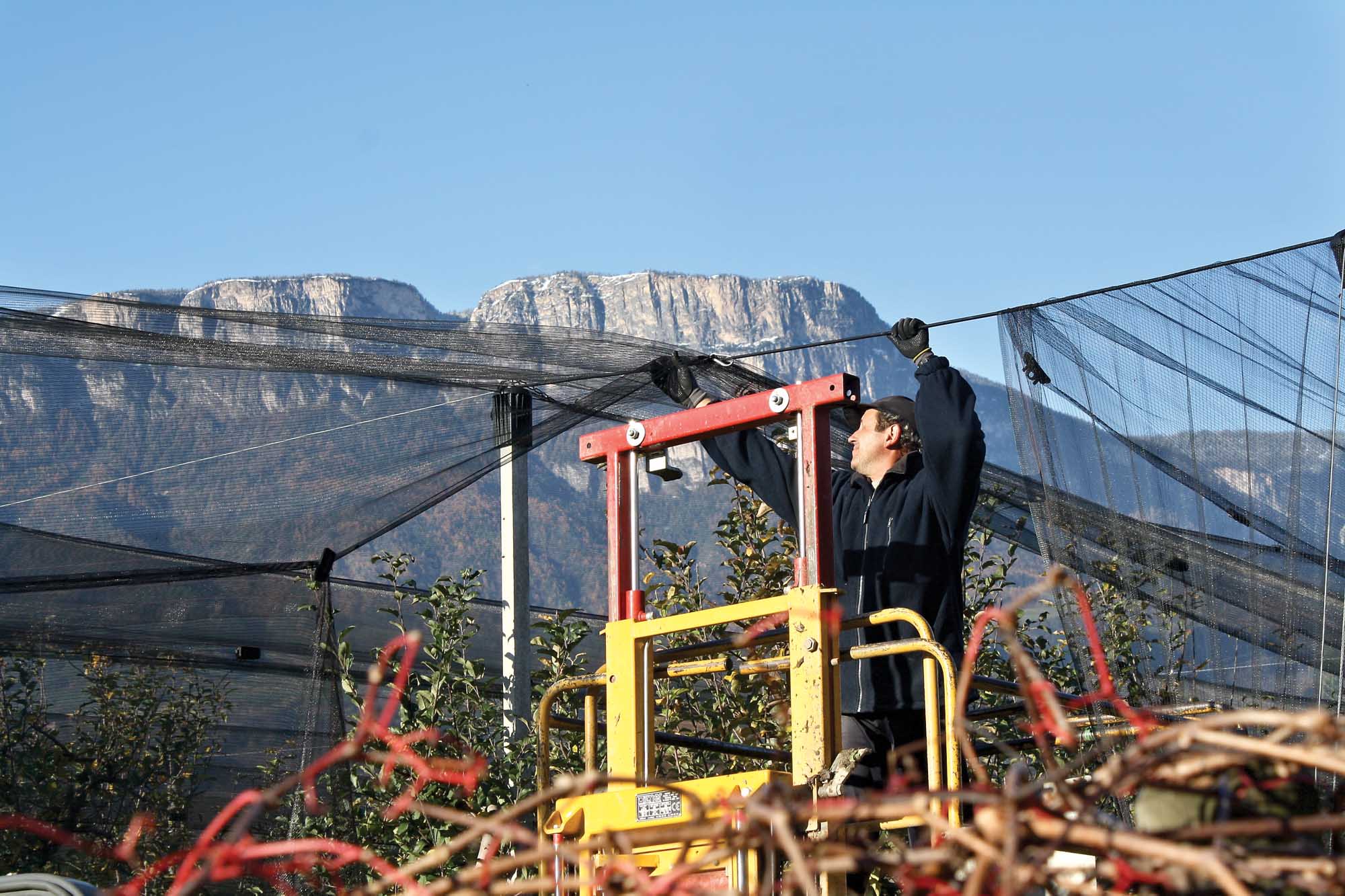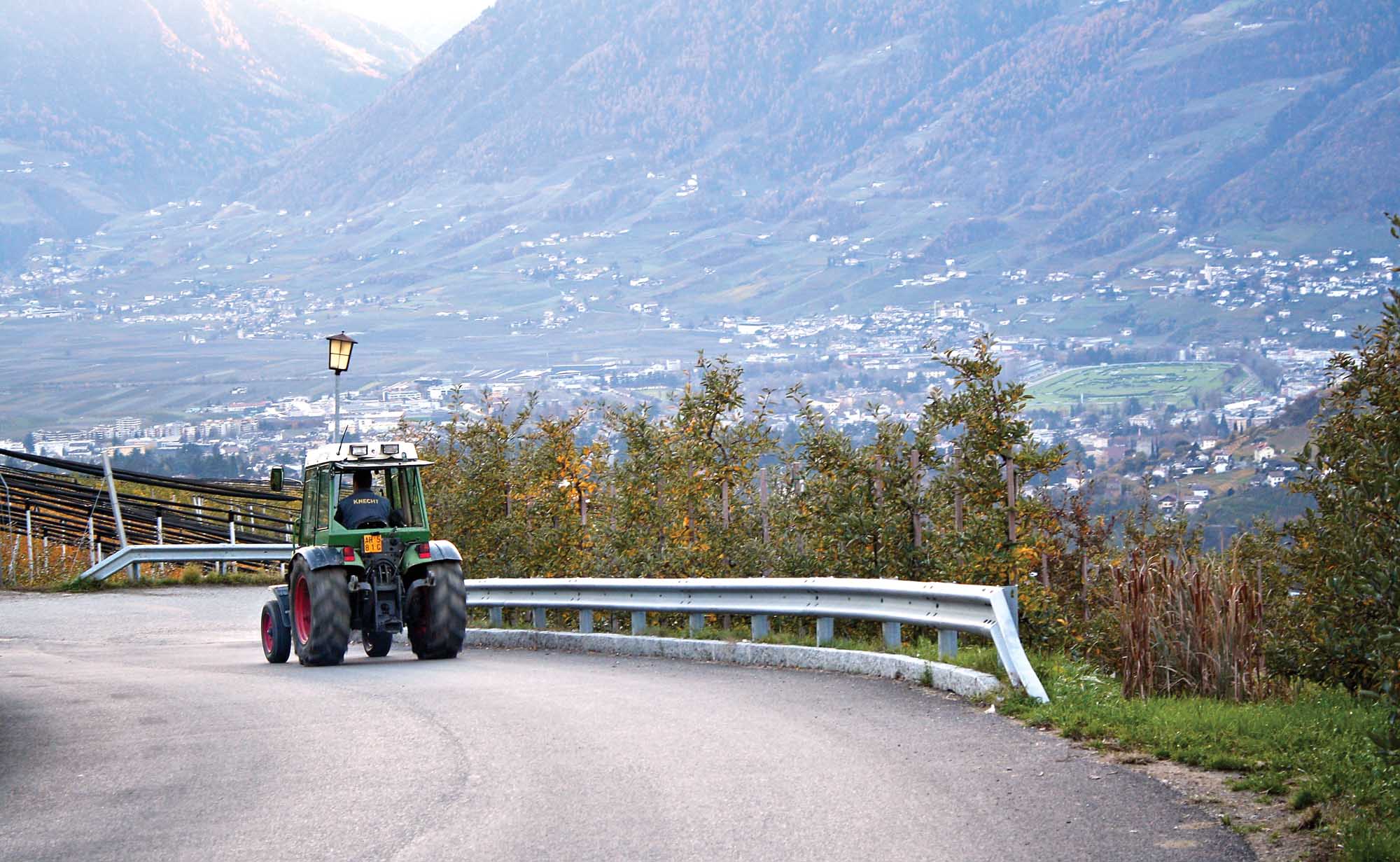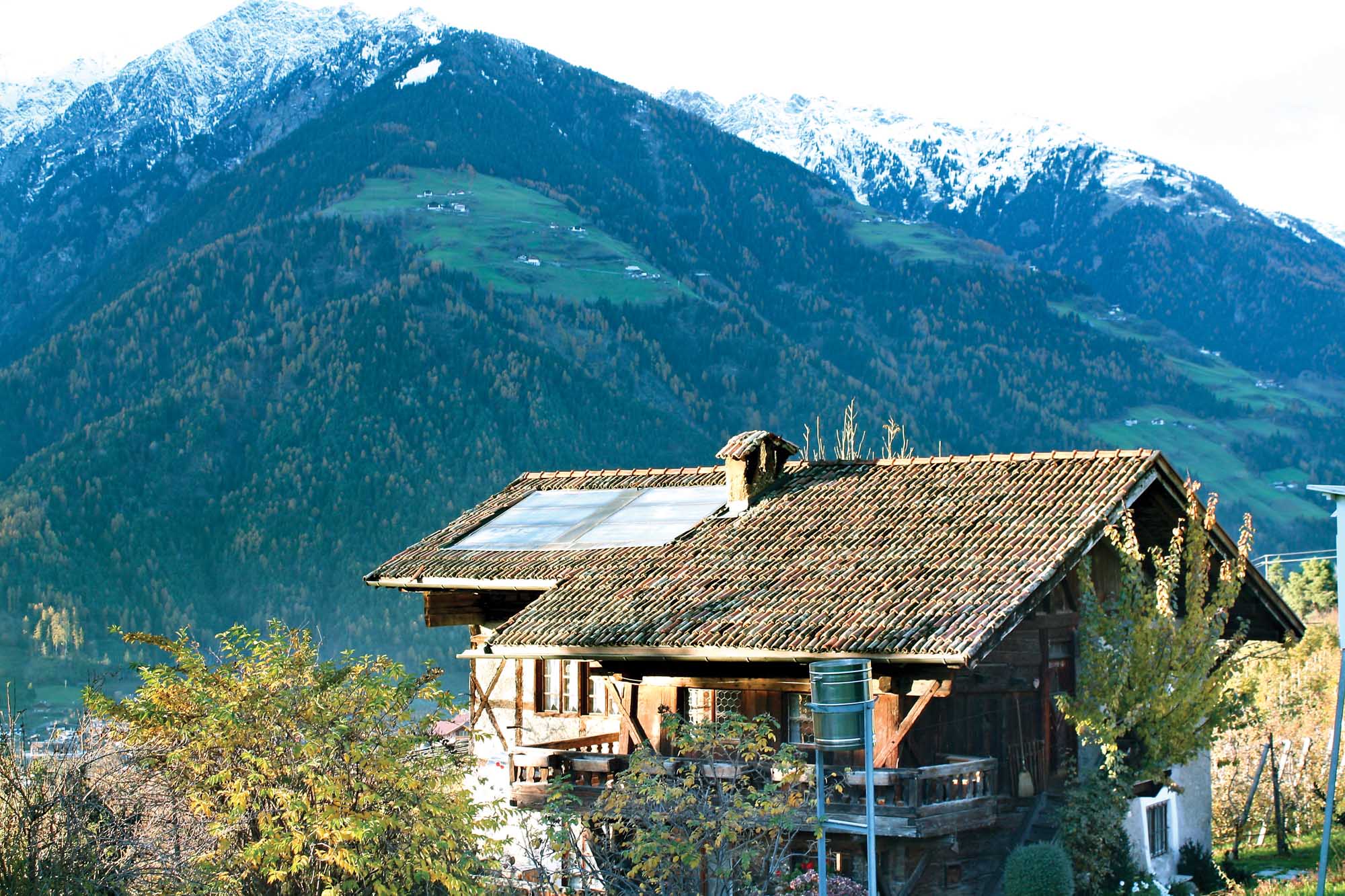
Nestled along the Alpine range, Italy’s northern province of South Tyrol (Sudtirol) has about 45,000 acres of apples, but most are on farms of less than 12 acres. Growers here collaborate in mighty cooperatives to produce about 58 million bushels each year. The 25-acre farm owned by grower Stefan Klotzner offers striking views.(Richard Lehnert/Good Fruit Grower)

Nearly all of the apples are under hail nets on the Kurt Komiss farm near Bolzano. (Richard Lehnert/Good Fruit Grower)

With yields averaging 1,300 and often reaching 2,200 bushels per acre, the South Tyrol region supplies half of Italy’s apple market and 15 percent of the European market. (Richard Lehnert/Good Fruit Grower)

The Stefan Klotzner homestead dates back to the early 1700s, but the family’s apple growing efforts began more recently with Klotzner’s grandfather.(Richard Lehnert/Good Fruit Grower)

The packing facility for the Merano region’s marketing co-op, VI.P’s Sudtirol Val Venosta. VI.P and a second large marketing cooperative, VOG, pack and sell 98 percent of the Tyrol’s apples. (Richard Lehnert/Good Fruit Grower)
What must it be like to have a small farm, say 10 acres, and have it in your family for decades, maybe centuries?
You grow up there and know every hill, every rock, every tree so well you could walk the place blindfolded. Now you’re the owner, and one of your children is out there walking around the place. The kid will one day take over, like you did.
As our American farms get larger, we lose this direct contact with the land. We delegate more work to hired laborers while we owner/managers focus on computer screens and tasks we call management. And we shrug and say, “Well, we have to give up some things to have others. We need to make more income.”
 On the apple farms of South Tyrol (Sudtirol), the German-speaking, most northerly Alpine province of Italy, the farmers seem to see it differently. In a 180-degree twist from the American way, they seem to delegate the “office” work to others and keep the “real” farm work for themselves.
On the apple farms of South Tyrol (Sudtirol), the German-speaking, most northerly Alpine province of Italy, the farmers seem to see it differently. In a 180-degree twist from the American way, they seem to delegate the “office” work to others and keep the “real” farm work for themselves.
Members of the International Fruit Tree Association who toured the South Tyrol in November weren’t sure who made the right decision, but they sure admired the most visible part of the outcome—the Tyrolean apple grower lifestyle. Lean and tanned and smiling, surrounded by mountain scenery, they have a laborer’s hands but certainly are not starving peasants.
American growers wondered: Have these farmers given up the real challenging part of the job—learning complicated processes, making choices and decisions, gaining the rewards and penalties for what they choose to do? No, they haven’t, but they don’t make the same choices and decisions over and over, farm by farm.
These Alpine growers are the most cooperative, community-oriented, congenial farmers imaginable. They compete, but not with each other. Land almost never changes hands, and there’s little incentive—or opportunity—to grow the farm larger.
They have given up some freedom of individual choice, opting for democratic participation in cooperatives (with one person, one vote), and they live by the will of the majority. By doing so, they have welded 6,000 small farms into a larger entity that produces high yields of uniform, high-quality apples, with a great brand image, a good market share, and some market power, generating good incomes for the small participants in this larger enterprise.
Moreover, while they continue to labor in the fields, they are highly innovative, adopting new varieties and new high-density orchard designs, methods for frost and hail prevention, and adopting machines that make their work easier.
As a group, their continuing challenge stems from the consequences of remaining farmers of very small orchards. Because growers tend to have outside jobs and are only marginally involved in orchard operations, they are limited in how much they can invest in steps to meet quality standards or invest in the right varieties.
The European machinery industry is eagerly working to serve the Alpine growers. IFTA visitors, who attended Europe’s big apple show Interpoma during their week-long trip, witnessed the competition among suppliers. There must be 30 companies selling platforms adapted for pruning, tree training, trellis and hail net construction, and harvesting. The machines are built for the rugged mountain terrain and sized and priced for the small grower. There seem to be no ladders left in Italy.
The industry
The size and structure of the South Tyrolean apple industry was described for the IFTA visitors by Kurt Werth, an industry veteran who spent 30 years in the South Tyrolean Advisory Service for Apple and Wine Growing and is now a private consultant. In 1998, he organized Interpoma, the 400-exhibitor orchard equipment show held each fall in Bolzano.
The 6,000 apple farms in Tyrol, most of them having less than 12 acres of orchard, produce about 58 million bushels of apples each year—about half the volume of Washington State and equal to the volume of New York State and Michigan combined. There are about 45,000 acres of apples. Only the larger growers—about 40 percent of the farms—rely totally on apples for their incomes. Yields are high, averaging above 2,200 bushels per acre on the best farms.
To cope with their small size, the growers have banded together, first in small cooperatives, then merging their co-ops into larger cooperatives. These large co-ops provide their members with a host of services.
The two large marketing co-ops are VI.P—the federation of nine co-ops of the Val Venosta in the upper valley from Merano west—and VOG, the 34 cooperatives of the long north-south valley with Bolzano near its center.
The South Tyrol production area is an officially designated European Union Geographic Production Area, similar to a wine appellation. It is on the sunny south side of the Alps, enjoying the mild Mediterranean climate and protected by the mountains from the continental climate.
With 300 sunny days a year, the warm days and cool nights produce high quality fruit, both in sugar and color, Werth said. The upper valley is particularly noted for their typey, blushed Golden Delicious. Orchards in the lower valley near Bolzano are from 600 to 800 feet in altitude, while orchards further up the valley are up to 3,000 feet above sea level.
Co-ops for everything
Given that the people of South Tyrol seem divided—they speak Italian, Germany, and an ancient Latin-like language called Ladin, and were once an Austrian province lost to Italy after World War I—they seem super-cooperative.
“Since the end of the Second World War, the various stakeholders involved in apple production and marketing have organized themselves,” Werth said. He calls the structure a LINSA, a “learning and innovation network for sustainable agriculture.”
“It is a highly sophisticated and adaptive network involving producers, their cooperatives and associations, a research station, agricultural advisory services, and other public and private actors, all collaborating in a network of linkages that function because of the high level of understanding and cooperation among all the stakeholders,” he wrote describing it.
As an example, the growers all need frost protection, and they all do it in the same way at the same time. They use overhead irrigation, supplied by abundant water from well and glacial river water, and it all runs at once, coating every orchard with a protective layer of ice.
At the other end, growers don’t pick apples when they want to—they pick according to the dictates of their marketing cooperative, which tests fruit for maturity and sets a time frame during which each grower must harvest and deliver or face penalties for lower quality.
Bins are owned by the co-ops (only indirectly by the growers), and growers fill them with apples and transport them to central facilities where they are stored, graded, packed, and sold under a brand. No apples are stored on farms.
The co-op inspects the apples as they are delivered, gives them a quality grade, and assigns them to long- or short-term storage. Growers are paid for quality, but all are paid alike for similar quality, no matter when the apples are sold. They receive several payments, with the fourth and last installment reflecting the co-op’s marketing performance for the entire year.
One of the brands used in marketing is VI.P’s Sudtirol Val Venosta—with a logo that shows a seven-spotted lady beetle over a green valley, the snow-capped mountains of the Orties Group, and blue sky. IFTA members spent several hours at VI.P’s super-modern, super-automated packing facility. •
————–
Industry strengths
Kurt Werth described the strengths of the South Tyrol region:
—Intensive culture, since acreage is limited.
—Italian policy is strongly pro-agricultural and the tax load is minimal.
—South Tyrol has considerable political autonomy with a local government that has “extensive competence.”
—There are well-organized institutions for research and education.
—Farm property is protected by the “closed farm system.” A law, passed in 1954, says that agricultural land cannot be divided by inheritance but should be passed down to one of the children to preserve the continuity of the single farm. Half of all the farms in South Tyrol (12,000 out of 26,600) were declared closed by the law.
—European Union support.
—A strong cooperative tradition.
—A central location in Europe.
—A single processing plant for industrial use of apples.






Anyone have a translation for the dog sign? Curious for exact wording. We would like to use something that explains WHY no pets allowed, as opposed to “please pick up after your pets”
Hi Amy:
My German’s not too great, but the sign translates like this:
This field is used for food production. Please do not soil with dog feces.The contamination of fields and meadows by dog feces has direct consequences. Cows longer graze in our orchards, and the transmission of diseases, especially neosporosis, which leads to abortion in cattle, needs to be excluded. In orchards and vineyards, dog feces represents a substantial problem. Therefore our request: respect the property, keep your favorite dog on a leash and our meadows and fields clean.
Richard
Hello, There is a feed going around on FB stating that Italy has some 900+ varieties of apples. I find this hard to believe. Do you know any different?
Thank you,
Celestina ????????
Good ideas – I am thankful for the insight . Does anyone know where I could get ahold of a blank MA DoR IFTA-1 example to use ?
Hi Dear,
Let me first introduce my self. I am a manager of a facility of storing sorting and packing apples. It is a cooperative of many small farmers in North Golan Heights, Israel. Usually we have about 15-20% of low quality apples (out of about 30,000 Tons), which carries alot of expenses for nothing. I am thinking to improve our facility for an an efficeint performance by taking out all the low quality apples after harvest via pre-sizing process and store only the good and high quality apples. I am hesitating as I’m not sure whether the pre-sizingprocess, in water ofcourse, might cause any kind of damage to the good apples during the long term storage.
I wounder if you can give me an advice from your experience about apple facilities that pre-size apples immediately after harvest, and then stored for long term cold storage.
Thanks
Asaad Safadi